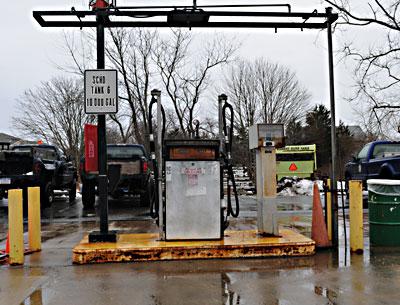Town and Village May Gas Up Together

East Hampton Town and East Hampton Village, both facing a need to repair the aging fuel tanks and pumps where their police, highway, and other official cars and trucks gas up, are banding together to seek grant money for the construction of a centralized, shared facility.
New York State’s Local Government Efficiency Program provides assistance and grants for the development of projects that achieve cost savings and improve efficiency through shared initiatives. With a March 13 deadline to apply for money, both town and village officials have been discussing the project.
Up to $400,000 in grant money could be available, Larry Cantwell, the East Hampton Village administrator, said yesterday. “That might very well pay for most of the cost of a new facility,” he said, adding that the remaining costs would involve dismantling the existing facilities.
The village’s fueling station at its Department of Public Works site on Accabonac Road is “23 years old or more,” Mr. Cantwell said at a village board meeting on Friday. “At some point we’re going to have to do a major upgrade of that system,” he said.
Mr. Cantwell and Scott Fithian, the village’s superintendent of public works, have been meeting with East Hampton Town officials, including Highway Superintendent Steve Lynch and a representative from the town police.
East Hampton Town has fueling facilities at its Highway Department and at the town police garage behind Town Hall, and shares a fueling site in Montauk with the Montauk Fire Department. The two main sites — both the underground fuel storage tanks and the fuel pumps — are “outdated, deteriorated, and in critical need of replacement,” Charlene Kagel, an accountant for the town, told the town board at a meeting on Tuesday with village officials.
The village board had hired Drew Bennett, a consulting engineer, to do a preliminary report on the redesign of its facility, at an estimated cost of $3,900.
Mr. Bennett will now proceed with work on behalf of both the village and the town, to prepare a cost-benefit analysis for the joint project and to design the centralized facility. Its location has not yet been determined, though it would be placed on town or village-owned land.
Mr. Bennett said at the town board meeting on Tuesday that he would evaluate whether two separate diesel fuel tanks maintained by the town’s Parks and Recreation and Sanitation Departments should be eliminated.
Whether or not the new fuel tanks will be installed above or below ground will also be decided, the engineer said.
The underground tanks now used by both the village and the town all date to the early 1980s, Mr. Bennett said. Though he “doesn’t anticipate any major can of worms” in their removal, “there’s always a risk of an accumulation of small spillage” of fuel that would have to be dealt with.
The new fuel pumps would be equipped with a computerized recordkeeping system to log which vehicles are getting gas. Ms. Kagel said that the system could tie in to a regional fueling station concept under discussion by public officials countywide, which would allow vehicles from any municipality to fuel up at participating stations. Bills would then be sent out to various towns and villages, accordingly.
The new site could include charging stations for electric cars and incorporate the use of alternative energy, Ms. Kagel said.
She said that Shelter Island Town and its school district had received a state grant for a similar project, and that “the likelihood is good” that the East Hampton application would also be successful.
Either way, Ms. Kagel said, for the town and village to pool their resources to build a new fuel facility “would make financial sense.”
The joint project is “an indication of the changing times with respect to local government,” East Hampton Village Mayor F. Paul Rickenbach Jr. said last week. “The village is pleased to cooperate with the town in this inter-municipal undertaking.”
“Shared services are not only good for the taxpayer, it’s a practical way to go,” East Hampton Town Supervisor Bill Wilkinson said on Tuesday. He pointed to a recent successful example, when the town and village jointly operated an emergency operations center during the last two big storms.
